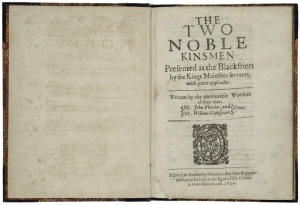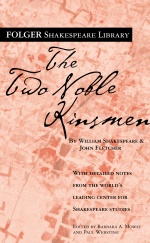The Two Noble Kinsmen: Difference between revisions
SophieByvik (talk | contribs) m (Made left-justified headings for Folios) |
|||
| (17 intermediate revisions by 5 users not shown) | |||
| Line 1: | Line 1: | ||
One of [[William Shakespeare's plays]], written by Shakespeare and John Fletcher, this play tells the familiar story of a love triangle. Here, though, it seems distant and strange. The play is based on "The Knight's Tale" in Chaucer's ''Canterbury Tales''. Chaucer's tale comes from an Italian poem by Boccaccio. Thus in ''The Two Noble Kinsmen'', we have a late medieval narrative transformed into a seventeenth-century play. | |||
Initially, the Theban knights Arcite and Palamon are devoted kinsmen, both serving their king, Creaon, who is defeated by Theseus, Duke of Athens. After they are imprisoned in Athens, they see Emilia, sister of the Duchess of Athens, through a window. They become rivals for her love, eager to fight each other to the death, even though she does not know they exist. | |||
After Arcite is released and banished, and Palamon escapes, they begin their would-be fight to the death with chivalric ceremony. Theseus, happening on them, decrees that they must compete for her in a tournament, after which the loser will be executed. | |||
Emilia is no willing bride; as a girl, she loved Flavina, who has died. Still, she tries to avert the tournament by choosing between Arcite and Palamon, only to find she cannot. The jailer's daughter, a character added by the playwrights, is infatuated with Palamon and helps him escape. But the social gulf between her and Palamon is unimaginably wide. Only the gods can bring the play to resolution. | |||
''The Two Noble Kinsman'' is thought to have been written in 1613, making it among the last of Shakespeare's plays. It was first published as a quarto in 1634. Shakespeare and Fletcher are named as the authors on the quarto's title page.<ref>Adapted from the Folger Library Shakespeare edition, edited by Barbara A. Mowat and Paul Werstine. © 2010 Folger Shakespeare Library.</ref> | |||
== Productions at the Folger == | == Productions at the Folger == | ||
== Early editions == | == Early editions == | ||
[[File:STC 11075 copy 3.jpg|thumb|300px|right|The 1634 Quarto title page of ''The Two Noble Kinsmen''. STC 11075 copy 3.]] | |||
'''Quarto''' | '''Quarto''' | ||
:LUNA: [http://luna.folger.edu/luna/servlet/s/ | :LUNA: [http://luna.folger.edu/luna/servlet/s/05307x/ Quarto (1634)] | ||
:Hamnet: [http://shakespeare.folger.edu/cgi-bin/Pwebrecon.cgi?BBID=161336/ STC 11075] | :Hamnet: [http://shakespeare.folger.edu/cgi-bin/Pwebrecon.cgi?BBID=161336/ STC 11075] | ||
== Modern editions == | == Modern editions == | ||
[[File:THE TWO NOBLE KINSMEN cover Folger Edition.jpg|150px|right]] | |||
''The Two Noble Kinsmen'' can be read online with [http://www.folgerdigitaltexts.org/?chapter=5&play=TNK&loc=p5/ Folger Digital Texts] and purchased from [http://books.simonandschuster.net/Two-Noble-Kinsmen/William-Shakespeare/Folger-Shakespeare-Library/9780671722968/ Simon and Schuster]. | |||
Hamnet link to Folger Edition: [http://shakespeare.folger.edu/cgi-bin/Pwebrecon.cgi?BBID=235681/ PR2753 .M6 2003 copy 2 v.40] | |||
==In popular culture== | |||
== Translations == | == Translations == | ||
| Line 21: | Line 45: | ||
== Other media == | == Other media == | ||
== Notes == | |||
<references /> | |||
[[Category: William Shakespeare's works]] | |||
[[Category: Plays]] | |||
[[Category: William Shakespeare's collaborations]] | |||
[[Category: Comedies]] | |||
[[Category: The Two Noble Kinsmen|Two Noble Kinsman, The]] | |||
[[Category: 17th century]] | |||
[[Category: Early modern drama]] | |||
Latest revision as of 07:08, 14 September 2020
One of William Shakespeare's plays, written by Shakespeare and John Fletcher, this play tells the familiar story of a love triangle. Here, though, it seems distant and strange. The play is based on "The Knight's Tale" in Chaucer's Canterbury Tales. Chaucer's tale comes from an Italian poem by Boccaccio. Thus in The Two Noble Kinsmen, we have a late medieval narrative transformed into a seventeenth-century play.
Initially, the Theban knights Arcite and Palamon are devoted kinsmen, both serving their king, Creaon, who is defeated by Theseus, Duke of Athens. After they are imprisoned in Athens, they see Emilia, sister of the Duchess of Athens, through a window. They become rivals for her love, eager to fight each other to the death, even though she does not know they exist.
After Arcite is released and banished, and Palamon escapes, they begin their would-be fight to the death with chivalric ceremony. Theseus, happening on them, decrees that they must compete for her in a tournament, after which the loser will be executed.
Emilia is no willing bride; as a girl, she loved Flavina, who has died. Still, she tries to avert the tournament by choosing between Arcite and Palamon, only to find she cannot. The jailer's daughter, a character added by the playwrights, is infatuated with Palamon and helps him escape. But the social gulf between her and Palamon is unimaginably wide. Only the gods can bring the play to resolution.
The Two Noble Kinsman is thought to have been written in 1613, making it among the last of Shakespeare's plays. It was first published as a quarto in 1634. Shakespeare and Fletcher are named as the authors on the quarto's title page.[1]
Productions at the Folger
Early editions
Quarto
- LUNA: Quarto (1634)
- Hamnet: STC 11075
Modern editions
The Two Noble Kinsmen can be read online with Folger Digital Texts and purchased from Simon and Schuster.
Hamnet link to Folger Edition: PR2753 .M6 2003 copy 2 v.40
In popular culture
Translations
Performance materials
Other media
Notes
- ↑ Adapted from the Folger Library Shakespeare edition, edited by Barbara A. Mowat and Paul Werstine. © 2010 Folger Shakespeare Library.

